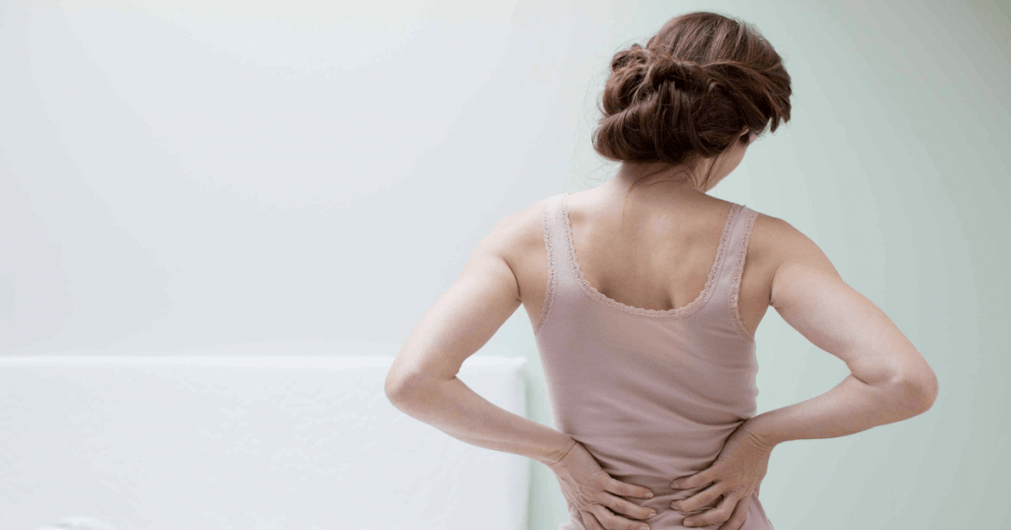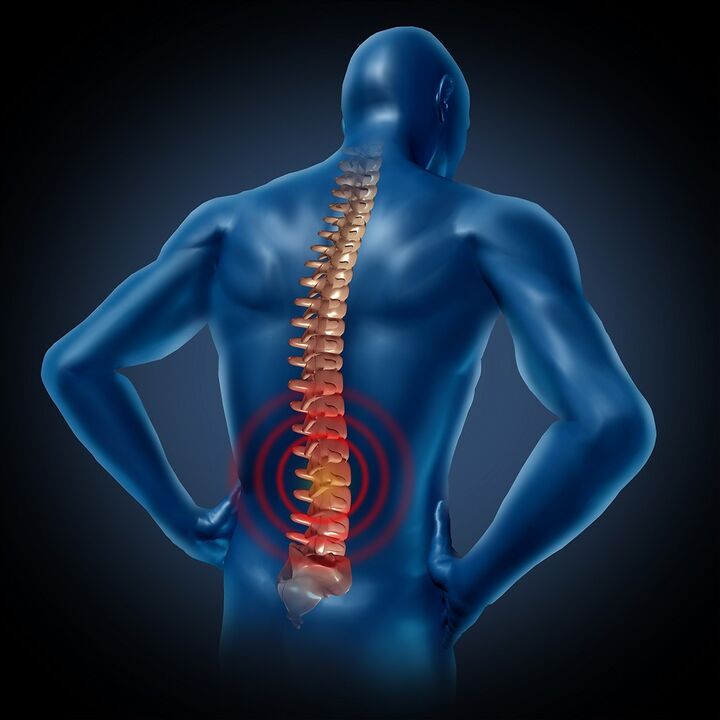Low back pain is less common than headache. Every adult has encountered this part at least once. Often the neck and lower back are affected. Doctors attribute this to a gradual decrease in physical activity, because many people both work on the computer and relax. This is the most common cause of chronic degenerative diseases of the musculoskeletal system, which is the most common cause of back pain. Timely examination and treatment, regular physical activity and normalization of body weight will help to get rid of anxiety and restore the joy of movement.

General Information
High back pain is associated with its anatomy. The main spine. Cartilaginous discs are located between the vertebrae that act as shock absorbers. Additional skeletal muscles and ligaments are provided. The spinal cord passes through the spinal column, from which the paired roots extend and innervate almost all organs and tissues.
A pathological process in any of the posterior structures, as well as in the internal organs associated with nerve fibers, can cause pain. Often a doctor must make a thorough diagnosis to find the source.
Reasons
Most of the conditions that cause pain in some parts of the back are chronic. They start gradually and are asymptomatic for a long time.
Among the external and internal causes that can lead to exacerbation are the most common:
- often lifting weights or increasing load on the spine against the background of excess weight;
- metabolic diseases;
- posture disorders and diseases of the musculoskeletal system (eg, arthrosis of the hip joint or straight legs), causing uneven distribution of the load;
- hypothermia;
- infectious and autoimmune inflammatory processes;
- bulky formations (tumors, abscesses);
- pathology of the internal organs of the chest or abdomen.
Diseases
Back pain can be a symptom of many diseases that can be divided into several groups.
Spinal or joint pathology
This is the most common cause of back pain. Most diseases are associated with high and / or uneven loading of the spine:
- osteochondrosis: the cartilage discs between the vertebrae begin to collapse, become thinner and are replaced by bone tissue; as a result, the damping function of the spine suffers and the spinal cord or root is often compressed;
- intervertebral hernia: the central part of the intervertebral disc extends to the spinal cord, compresses it; the problem often arises against the background of advanced osteochondrosis;
- ankylosing spondylitis: autoimmune inflammation of the joints and lumbar spine, causing painful spasms of the surrounding muscles; over time, it causes the vertebrae to join together;
- spondylolisthesis: displacement of the vertebrae from their normal position, which can cause compression of the roots or spinal cord;
- rheumatoid arthritis: inflammation of the joints of autoimmune nature; affects the cervical spine more;
- osteomyelitis: inflammation of the bone tissue.
Muscle tissue pathology
Muscle tissue is often involved in the pathological process in the pathology of bone tissue or joints. In this case, painful spasms occur in the affected area. In addition, pain can occur against the background of:
- fibromyalgia: chronic pain in muscles and ligaments, often accompanied by stiffness and stiffness;
- myositis: an inflammatory process that occurs in the muscles against the background of hypothermia, stretching, injury or physical overload;
- Dermatomyositis: Chronic damage to the skin, muscles, and internal organs, most likely of an autoimmune nature.
Spinal cord and root pathology
Often the pain occurs against the background of compression of certain areas of nerve tissue due to trauma, tumor, osteochondrosis or disc herniation. An isolated lesion can cause:
- inflammation associated with infection, including HIV and syphilis;
- multiple sclerosis;
- bleeding;
- lack of oxygen;
- vitamin or mineral deficiency.
Internal organ pathology
The innervation of most internal organs is carried out by the root of the spinal cord. As a result, any pathological process inside them can turn into a back pain. Doctors often face the following problems:
- renal pathology: pyelonephritis, urolithiasis;
- inflammation of the pelvic organs: salpingitis, salpingo-oophoritis, prostatitis;
- pathology of the gallbladder: cholecystitis, cholelithiasis;
- damage to the cardiovascular system: angina, heart attack, aortic aneurysm, pulmonary embolism;
- Respiratory diseases: pleurisy, pneumonia, abscesses, pneumothorax;
- appendicitis.
Nature and localization of pain
The localization and nature of emotions can say a lot about their source. It is important to explain to your doctor exactly how your back hurts so that you can determine the cause and get treatment as soon as possible.
Depending on the nature of the pain may be:
- acute: often occurs on the background of osteochondrosis, intervertebral hernia, lumbago or radiculitis, usually aggravated by movement;
- painful: characteristic of chronic inflammatory processes in muscles, joints or internal organs;
- bruising or eruption: most often speaks of acute or chronic pathology of the internal organs;
- pulsating, strong: generally associated with exacerbation of trauma, lumbago, spondylosis, osteochondrosis.
The localization of the pain syndrome can also help to make a diagnosis:
- right: liver, gallbladder, duodenal pathology, right ovarian or kidney damage, appendicitis;
- left: splenic pathology, left kidney or ovary, myocardial infarction, pancreatitis;
- in the lumbar region: sciatica, osteochondrosis, lumbago, Reiter's syndrome, intervertebral hernia;
- below the waist: osteochondrosis or intervertebral hernia, bilateral inflammation of the ovaries, uterine pathology, menstrual cramps;
- under the right scapula: liver, gallbladder, pathology of the pancreas, right intercostal neuralgia, pleurisy, pneumonia;
- under the left shoulder blade: heart disease, left-sided pneumonia, pleurisy, intercostal neuralgia, etc.
If you need to see a doctor immediately
Back pain can be both a sign of a relatively harmless pathology and evidence of a dangerous process that requires urgent medical attention. A person should immediately consult a specialist in the following cases:
- pain occurred after injury;
- it is impossible to find a position where the pain is relieved;
- there is an increase in temperature;
- Signs of nerve damage appear: numbness, tingling, muscle weakness;
- more pain at night;
- sensations are accompanied by weakness, darkening of the eyes, palpitations, cold sweats;
- painkillers do not provide relief;
- the disease progresses despite treatment;
- blood pressure changed sharply (increased or decreased);
- you have trouble urinating or your urine has changed color;
- the pain spread to the chest and abdomen;
- The condition is accompanied by nausea, vomiting, profuse loose or delayed stools.
In general, a suspicious symptom that is not noted in previous pain attacks should alert the patient and be a reason for emergency medical care.
Diagnostics
Examination for low back pain includes:
- collection of complaints and medical history, clarification of the conditions, nature, intensity, localization and other important parameters of the onset of pain, identification of risk factors for various diseases;
- general examination with measurement of blood pressure, assessment of heart rate, respiration, temperature;
- neurological examination: assessment of sensory and motor functions, quality of reflexes;
- laboratory diagnostics: general blood and urine tests, basic biochemical blood test; if necessary, tests are prescribed to confirm or rule out a certain pathology;
- ECG, ultrasound examination of the heart;
- Spinal radiography, CT or MRI;
- Ultrasound examination of the abdominal organs, small pelvis;
- chest radiography;
- Doppler ultrasound examination of the neck and cerebral vessels;
- electromyography: assessment of the quality of conduction of nerve impulses through muscle fibers;
- Consultations of narrow specialists: nephrologist, cardiologist, gynecologist, etc.
The list of tests, diagnostic procedures and consultations may vary depending on the patient's complaints.

Treatment of low back pain
The choice of treatment depends on the cause. Doctors often deal with pathology of the musculoskeletal system and nervous tissue. In this case, painkillers are the basis of therapy:
- non-steroidal anti-inflammatory drugs;
- hormonal agents;
- muscle relaxant: relieve muscle spasms;
- B vitamins: improve the condition of nerve tissue;
- narcotic analgesics: with ineffectiveness of drugs from other groups.
Additional procedures help to increase the effectiveness of drug treatment:
- physiotherapy: electro- and phonophoresis, laser and magnetic therapy, electronurostimulation;
- massage;
- manual treatment;
- physiotherapy.
Special methods are chosen by the doctor depending on the cause and individual characteristics of the organism. In some cases, surgical treatment is prescribed.
Prevention
Back pain can be prevented. To do this, you must follow the following rules:
- prevention of hypodynamics: gymnastics, sports (without overload);
- avoid stress;
- good rest;
- eat right, avoid gaining weight;
- avoid heavy lifting;
- correct posture disorders;
- Get regular medical check-ups and timely treatment of chronic diseases.
Low back pain can be mild or completely immobilizing. Avoid the crisis, consult a doctor at the first sign of a problem.


















































